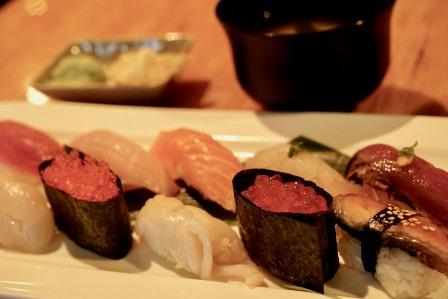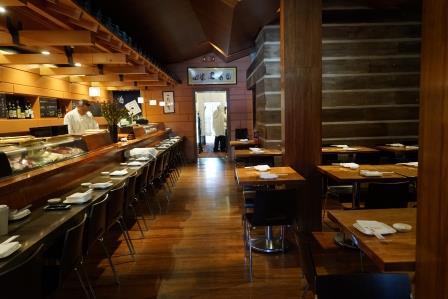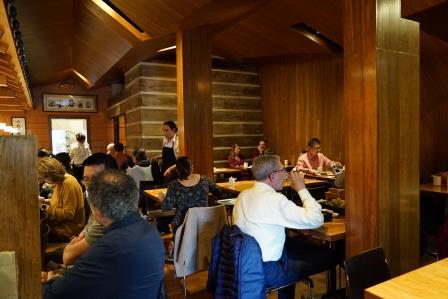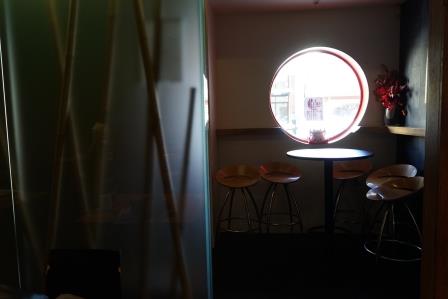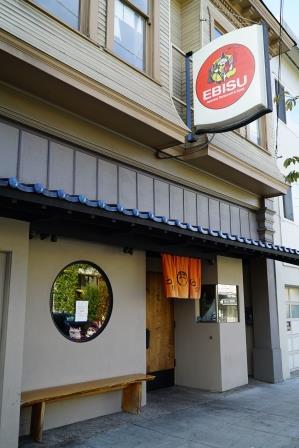A long-established sushi restaurant loved by the region —Sustaining while changing—
By Elli Sekine
Ebisu, which is going into their 37th year of operation this year, is a long-established restaurant that has been leading the sushi boom in San Francisco. This restaurant is located near the center of the Golden Gate Park, and had become a super popular place in the nineties, where people would wait in line for a long time. Since then, they have tried diversified management styles, and tried out new sushi business models. Actually, in the past 30 years, they have expanded the business by opening 3 new restaurants, then closing them, and currently running only the main location. In their history, you can identify the pros and cons of a family-run operation. Ebisu has always been particular about quality and originality, and therefore, it was their management strategy to match the trends of the time. “The fundamentals are the most important things for the operation, which are consistent procurement of fresh ingredients, and the management,” says Erick, the 2nd generation owner.
Changing of management style according to the time…
In 1999, Ebisu Family’s second location, “Hotei,” opened. It was a noodle specialty restaurant which no one paid attention to at that time. The secret dashi made at the main location across the street was used for the noodle soups, and their wide variety of menu items that included udon, soba, somen, showa-taste ramen, etc., and its casual atmosphere made this place a hit. “As long as the base for Japanese cuisine is solidly mastered, you can create any dish,” at that time said Steve who is the founder, and currently the chairman. Especially, the “Reimen (cold noodle)” with house-made rich sauce, which you could not get anywhere else, was their top menu item. Ususally, average time people spend at a noodle specialty restaurant is not long, and therefore, its rotation is quick. From the customers’ point of view, it was really convenient that the restaurant was open from lunch through dinner time, and it was nice that they could have Ebisu’s roll sushi at a reasonable price. This location, thus quickly became very popular. Some customers who could not get into “Ebisu” went there, too. However, due to the ramen boom that came later, those customers slowly left for wanting of the new thing, ramen. For the 2 years prior to closing “Hotei”, they tried to continue by changing the owner, but finally closed its doors in 2015.
Catering sushi for parties…
In the 2000s, the core business that they were running along with the restaurant business was catering of sushi for parties, and catering for business offices.
With catering for weddings to business meetings at renowned hotels, they were extremely busy. The catering business was rapidly growing around that time as a new food business model. Erick, who was the leader of their catering business said, “It was really crazy, the situation we were in”, as he reminisced about those days when he was rushing around like crazy with his father and brothers. Presently, they are developing a well-balanced business based on the main location as the core.
“Airport Ebisu”, the second location of “Ebisu”, and “Hotei”, the second location of “Hotei” at the Financial District
In the early 2000s, the “Ebisu” family opened a branch at the new international terminal of SFO (San Francisco airport) which is known as “the most gourmet airport”. Ebisu was really standing out amongst the selection of restaurants and stores there, where the food culture unique to Northern California with the highest Asian population was symbolized in. Furthermore, the second “Hotei” opened in the Finance District, and their business was at its peak. On the other hand, in the background of such successes, they were having constant hardships with administering of employees, and the management. The distance from the main restaurant seemed to be one of the reasons. The idea of Steve’s, “to keep everybody within the reach of his supervision”, was far from the reality. It was also the time when maintaining of human resources was not catching up with the demands of the rapidly growing Japanese food businesses.
In the second half of the 2000s, San Francisco went into the IT bubbling period, and high-end Japanese restaurants were appearing one after another. Fine dining restaurants that served Omakase and Kaiseki courses increased in number in a very short time. Ebisu did a renovation of the entire restaurant in 2008, but did not change their position all throughout the past 30 years as a casual, locally based restaurant. Because of it, they still keep long-time regular customers without getting distracted by new trends. Moreover, due to the renovation, the older image of them, which is a usual typical sushi restaurant of the nineties, has transformed to a modern, bright, and spacious kind, which is drawing new types of customers. Adding more counter seats is contributing to the increase in the number of single customers.
The long-lasting Ebisu, which was established by a single generation, has been going forward by changing their business format along the way with the times. What has not changed is their offering of fresh ingredients, and their support of the local regular customers. Their family operation principle in which they do not rely completely on strangers, has been carried over to the second generation, and is still evolving.
地域に愛される寿司の老舗
-変わりながら持続する-
今年で創業37年目となるEbisuは、サンフランシスコで寿司ブームを牽引して来た老舗。ゴールデンゲートパークのほぼ中央に位置するサンセット地区で90年代、行列の出来る繁盛店となった。その後多角経営に挑戦し、新しい寿司店の在り方を実践して来た。実際、この30年で3軒の新規店舗を拡大しクローズし、現在は本店のみが既存している。そこには、家族経営の良さと難しさが見えてくる。また、品質とオリジナリティにこだわるEbisuならではの時代に合わせた経営戦略でもあった。「経営は基本が最も大切。それは一貫して新鮮な食材の仕入れとマネージメントです」と2代目店主のエリックさんは語る。
時代に合わせ経営形態を変える
1999年、Ebisuファミリー第2号店となる「Hotei」をオープンした。当時まだ誰も見向きもしなかったヌードル店だ。通り向かいに位置する本店で毎日取る秘伝出汁をヌードルスープに応用する手順でうどん、蕎麦、そうめん、そして昭和の味のラーメンなど豊富なメニューとカジュアルさがウケた。「和食の基本さえしっかりしていれば、どんなメニューでも創作できる」と当時、創始者で現会長のスティーブさんは言っていた。特に自家製コッテリタレの「冷麺」はここでしか食べられない絶品メニューだった。ヌードル店は平均食事時間が少く回転も早い。客にとっては営業時間はランチタイムから通しで便利であり、お得な値段でEbisuのロール寿司を食べられると言う事でたちまち繁盛店となった。「Ebisu」に入れない客も流れていた。しかしその後到来したラーメンブームにより、客は新しいラーメンを求めて散って行った。閉店前2年間はオーナーチェンジをし、2015年「Hotei」はそのドアを閉じた。
パーティ寿司ケータリング
2000年代、レストラン営業と同時に経営の柱となっていたのが、パーティー出張寿司とビジネスケータリングだ。結婚式から著名なホテルのミーティングまで引っ張りだことなった。ケータリングが新しい食ビジネスとして急成長したのもこの頃。その中心となって支えてきたエリックさんは、「状況はクレージーだった」と父、兄弟と走り回った当時を振り返る。現在、本店を軸としたバランスの良いビジネスを展開している。
エアポート「Ebisu 」2号店と金融街の「Hotei」2号店
2000年代初頭、「Ebisu」ファミリーは、「全米で一番グルメな空港」と呼ばれるSFO(サンフランシスコ空港)の新国際ターミナルに支店を出した。アジア人口の比率が最も多い北カリフォルニアならではの食文化を象徴した店舗セレクションの中でEbisuは際立っていた。さらに「Hotei」2号店も金融街にオープンし、経営は最高潮に達していた。しかしその裏では人事やマネージメント面での苦労が耐えなかったという。本店から距離が遠いこともあり、「常に目が届く範囲」というスティーブさんの思惑からかけ離れていたようだ。急激な日本食需要に人材確保が追い付かない時代でもあった。
本店の大改装
2000年代後半からサンフランシスコはITバブル期に突入し、和食高級店が続々と出現し、Omakaseや懐石メニューを提供する“ハイエンド”レストランが一気に増えた。Ebisu は2008年に店内の全面改装をしたが、30数年間通してきた地元密着型のカジュアルレストランの位置付けは変えなかった。その為トレンドに惑わされる事なく長年の常連客を確保している。更に改装により、90年代の平凡な寿司店のイメージはモダンで当たるく広々としたイメージに代わり、新しい客も呼び込んでいる。カウンター席が増えた事で一人客も増えている。
一代で築いた老舗Ebisuは時代と共にビジネスの形態を変えながら歩んで来た。変わらないのは新鮮なネタの提供と地域の常連客のサポートだ。他人任せにしない家族経営店の信念は今2代目へと引き継がれ、更なる進化を遂げようとしている。
Ebisu
1283 9th Ave
San Francisco, CA
(415) 566-1770
https://ebisusushi.com
lunch
Monday to Friday 11:30-14:00
Saturday 11:30-14:30
Dinner
Monday to Thursday 17:00-22:00
Friday ,Saturday 17:00-23:00
Ebisu, which is going into their 37th year of operation this year, is a long-established restaurant that has been leading the sushi boom in San Francisco. This restaurant is located near the center of the Golden Gate Park, and had become a super popular place in the nineties, where people would wait in line for a long time. Since then, they have tried diversified management styles, and tried out new sushi business models. Actually, in the past 30 years, they have expanded the business by opening 3 new restaurants, then closing them, and currently running only the main location. In their history, you can identify the pros and cons of a family-run operation. Ebisu has always been particular about quality and originality, and therefore, it was their management strategy to match the trends of the time. “The fundamentals are the most important things for the operation, which are consistent procurement of fresh ingredients, and the management,” says Erick, the 2nd generation owner.
Changing of management style according to the time…
In 1999, Ebisu Family’s second location, “Hotei,” opened. It was a noodle specialty restaurant which no one paid attention to at that time. The secret dashi made at the main location across the street was used for the noodle soups, and their wide variety of menu items that included udon, soba, somen, showa-taste ramen, etc., and its casual atmosphere made this place a hit. “As long as the base for Japanese cuisine is solidly mastered, you can create any dish,” at that time said Steve who is the founder, and currently the chairman. Especially, the “Reimen (cold noodle)” with house-made rich sauce, which you could not get anywhere else, was their top menu item. Ususally, average time people spend at a noodle specialty restaurant is not long, and therefore, its rotation is quick. From the customers’ point of view, it was really convenient that the restaurant was open from lunch through dinner time, and it was nice that they could have Ebisu’s roll sushi at a reasonable price. This location, thus quickly became very popular. Some customers who could not get into “Ebisu” went there, too. However, due to the ramen boom that came later, those customers slowly left for wanting of the new thing, ramen. For the 2 years prior to closing “Hotei”, they tried to continue by changing the owner, but finally closed its doors in 2015.
Catering sushi for parties…
In the 2000s, the core business that they were running along with the restaurant business was catering of sushi for parties, and catering for business offices.
With catering for weddings to business meetings at renowned hotels, they were extremely busy. The catering business was rapidly growing around that time as a new food business model. Erick, who was the leader of their catering business said, “It was really crazy, the situation we were in”, as he reminisced about those days when he was rushing around like crazy with his father and brothers. Presently, they are developing a well-balanced business based on the main location as the core.
“Airport Ebisu”, the second location of “Ebisu”, and “Hotei”, the second location of “Hotei” at the Financial District
In the early 2000s, the “Ebisu” family opened a branch at the new international terminal of SFO (San Francisco airport) which is known as “the most gourmet airport”. Ebisu was really standing out amongst the selection of restaurants and stores there, where the food culture unique to Northern California with the highest Asian population was symbolized in. Furthermore, the second “Hotei” opened in the Finance District, and their business was at its peak. On the other hand, in the background of such successes, they were having constant hardships with administering of employees, and the management. The distance from the main restaurant seemed to be one of the reasons. The idea of Steve’s, “to keep everybody within the reach of his supervision”, was far from the reality. It was also the time when maintaining of human resources was not catching up with the demands of the rapidly growing Japanese food businesses.
In the second half of the 2000s, San Francisco went into the IT bubbling period, and high-end Japanese restaurants were appearing one after another. Fine dining restaurants that served Omakase and Kaiseki courses increased in number in a very short time. Ebisu did a renovation of the entire restaurant in 2008, but did not change their position all throughout the past 30 years as a casual, locally based restaurant. Because of it, they still keep long-time regular customers without getting distracted by new trends. Moreover, due to the renovation, the older image of them, which is a usual typical sushi restaurant of the nineties, has transformed to a modern, bright, and spacious kind, which is drawing new types of customers. Adding more counter seats is contributing to the increase in the number of single customers.
The long-lasting Ebisu, which was established by a single generation, has been going forward by changing their business format along the way with the times. What has not changed is their offering of fresh ingredients, and their support of the local regular customers. Their family operation principle in which they do not rely completely on strangers, has been carried over to the second generation, and is still evolving.
地域に愛される寿司の老舗
-変わりながら持続する-
今年で創業37年目となるEbisuは、サンフランシスコで寿司ブームを牽引して来た老舗。ゴールデンゲートパークのほぼ中央に位置するサンセット地区で90年代、行列の出来る繁盛店となった。その後多角経営に挑戦し、新しい寿司店の在り方を実践して来た。実際、この30年で3軒の新規店舗を拡大しクローズし、現在は本店のみが既存している。そこには、家族経営の良さと難しさが見えてくる。また、品質とオリジナリティにこだわるEbisuならではの時代に合わせた経営戦略でもあった。「経営は基本が最も大切。それは一貫して新鮮な食材の仕入れとマネージメントです」と2代目店主のエリックさんは語る。
時代に合わせ経営形態を変える
1999年、Ebisuファミリー第2号店となる「Hotei」をオープンした。当時まだ誰も見向きもしなかったヌードル店だ。通り向かいに位置する本店で毎日取る秘伝出汁をヌードルスープに応用する手順でうどん、蕎麦、そうめん、そして昭和の味のラーメンなど豊富なメニューとカジュアルさがウケた。「和食の基本さえしっかりしていれば、どんなメニューでも創作できる」と当時、創始者で現会長のスティーブさんは言っていた。特に自家製コッテリタレの「冷麺」はここでしか食べられない絶品メニューだった。ヌードル店は平均食事時間が少く回転も早い。客にとっては営業時間はランチタイムから通しで便利であり、お得な値段でEbisuのロール寿司を食べられると言う事でたちまち繁盛店となった。「Ebisu」に入れない客も流れていた。しかしその後到来したラーメンブームにより、客は新しいラーメンを求めて散って行った。閉店前2年間はオーナーチェンジをし、2015年「Hotei」はそのドアを閉じた。
パーティ寿司ケータリング
2000年代、レストラン営業と同時に経営の柱となっていたのが、パーティー出張寿司とビジネスケータリングだ。結婚式から著名なホテルのミーティングまで引っ張りだことなった。ケータリングが新しい食ビジネスとして急成長したのもこの頃。その中心となって支えてきたエリックさんは、「状況はクレージーだった」と父、兄弟と走り回った当時を振り返る。現在、本店を軸としたバランスの良いビジネスを展開している。
エアポート「Ebisu 」2号店と金融街の「Hotei」2号店
2000年代初頭、「Ebisu」ファミリーは、「全米で一番グルメな空港」と呼ばれるSFO(サンフランシスコ空港)の新国際ターミナルに支店を出した。アジア人口の比率が最も多い北カリフォルニアならではの食文化を象徴した店舗セレクションの中でEbisuは際立っていた。さらに「Hotei」2号店も金融街にオープンし、経営は最高潮に達していた。しかしその裏では人事やマネージメント面での苦労が耐えなかったという。本店から距離が遠いこともあり、「常に目が届く範囲」というスティーブさんの思惑からかけ離れていたようだ。急激な日本食需要に人材確保が追い付かない時代でもあった。
本店の大改装
2000年代後半からサンフランシスコはITバブル期に突入し、和食高級店が続々と出現し、Omakaseや懐石メニューを提供する“ハイエンド”レストランが一気に増えた。Ebisu は2008年に店内の全面改装をしたが、30数年間通してきた地元密着型のカジュアルレストランの位置付けは変えなかった。その為トレンドに惑わされる事なく長年の常連客を確保している。更に改装により、90年代の平凡な寿司店のイメージはモダンで当たるく広々としたイメージに代わり、新しい客も呼び込んでいる。カウンター席が増えた事で一人客も増えている。
一代で築いた老舗Ebisuは時代と共にビジネスの形態を変えながら歩んで来た。変わらないのは新鮮なネタの提供と地域の常連客のサポートだ。他人任せにしない家族経営店の信念は今2代目へと引き継がれ、更なる進化を遂げようとしている。
Ebisu
1283 9th Ave
San Francisco, CA
(415) 566-1770
https://ebisusushi.com
lunch
Monday to Friday 11:30-14:00
Saturday 11:30-14:30
Dinner
Monday to Thursday 17:00-22:00
Friday ,Saturday 17:00-23:00





